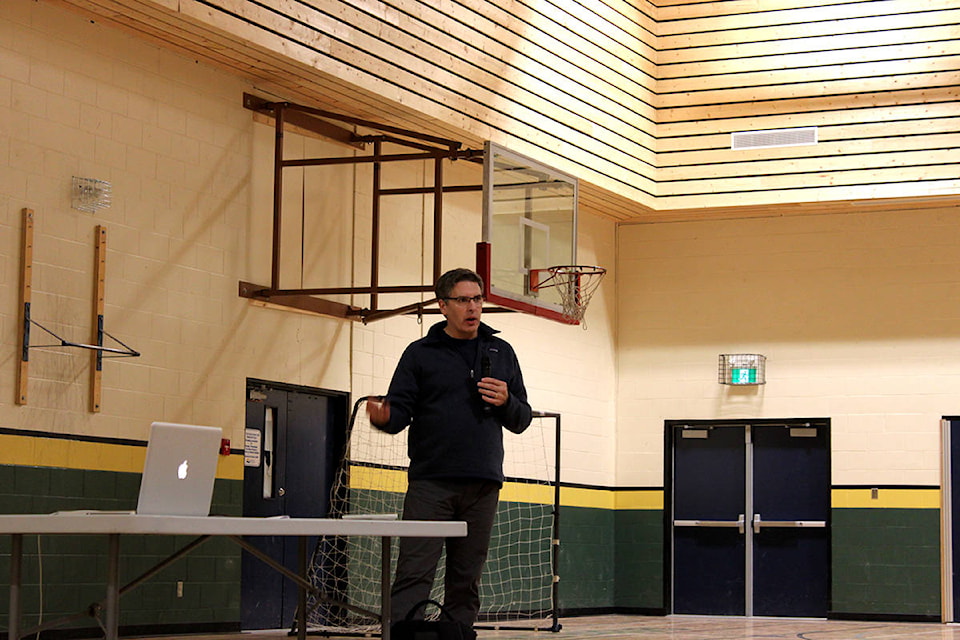Wildfires will ravage the South Cariboo region again, say experts during a presentation at the Peter Skene Ogden Secondary School (PSO) on Nov. 29.
“Unfortunately, what you experienced here this summer is going to happen again and its conditions will likely be worse,” said Robert Gray, an expert on fires, who started his career as a fire ecologist in 1993 for the San Carlos Apache Tribe in Arizona. “I’m sorry but there is no good news, it’s just all bad news.”
He now runs R.W. Gray Consulting, specializing in fire and ecological restoration based in Chilliwack.
Gray fielded questions at PSO after the audience watched Era of the Megafires, a film presentation by US Forest Service Research Ecologist Dr. Paul Hessburg and listened to Gray’s smaller presentation in conclusion.
One of the points raised by Gray was how we cannot rely on La Niña years anymore. La Niña is one half of the El Niño-Southern Oscillation climate pattern, an ocean-atmosphere phenomenon occurring randomly. The other half is El Niño.
The former is associated with colder and wet weather in the eastern Pacific Ocean and causes above-average precipitation and colder and windier seasons in British Columbia.
The latter is the opposite, dry and hot summers with wind.
“So we had this La Niña forecast happen [2016-17],” said Gray. “It was spring and then it happened and it doesn’t normally do this, so the fact we can’t count on La Niña anymore kind of puts us in into some strange territory.
In July, the entire southern half of the province was in red. It was high to extreme, everything north of the that was soaking wet and cold, so basically, the high-pressure system pushed the jet streams north but under that dome, everything south of that was hot, dry and windy. What happens is we get stronger wind events.”
Every time a low-pressure system sneaks into the jet streams and circulates the province it can create dry lightning, where a single spark could create a fire and the wind would sweep it across the dry landscape, such many fires during the summer, he said.
A longer fire season can dry out several fuel sources for a fire and when they catch, they really burn, causing high burn severity, essentially boiling the soil.
According to both Hessburg and Gray, the only way to stop wildfires is controlled burning creating patches of forests instead of one huge forest, making the landscape similar to pre-colonization period forests, which were patchy. First Nations people used controlled burning to help not just regrow food sources but create fireguards, this practice died away during the 1930s.
“The only thing that is going to stop fires is those patches in the landscape,” said Gray. “Roads, rivers and that stuff, they don’t have any impact on those fires.”
Even those patches are only temporary, impeding fire for only a period of three to five years before the grass and shrubbery regrow and become a fire hazard again. Gray likened it to basically putting the brakes on in your car but eventually break lines fail.
So to lower the impact of any future fires, a lot of these patches should be across the landscape.
Gray, along with other fire ecologists and experts, wrote a white paper recommending how the province should try to prevent future fires, such as the aforementioned controlled burning to create patches to protect crown land but also creating avenues for private landowners to do the same.
“Fire safety has been a struggle, it’s like a leaky bucket,” said Gray. “If we treat crown land and municipal land there’s still this big belt around communities that’s untreated, so the fire will go right through it.”
The white paper recommends the province invest in a cost-share program or fund private fire safety outright, where small rural community members who have no access to resources or expertise can reach out to British Columbia Wildfire Service staff to develop plans to protect their homes.
